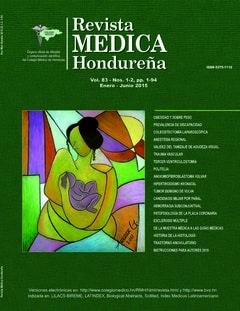Prevalence of disability and its characteristics in 18 to 65 years old population in Honduras, Central America, 2013-2014
Keywords:
Disability evaluation, Disabled persons, Honduras, International Classification of Functioning, Disability and Health, Working-age populationAbstract
Background: It is necessary to assess the situation of working-age people with disabilities to contribute to their social integration. Objective: To determine the prevalence of disability and its characteristics in subjects 18-65 years of age, Honduras 2013- 2014. Methods: Descriptive cross-sectional association study. Last year medical students, Facultad de Ciencias Médicas UNAH, visited 50 inhabited houses from randomly selected communities, recording number of inhabitants and prior written informed consent, information of individuals with permanent disabilities >1 year (WHO-DAS II, International Classification of Functioning, WHO). The involvement in function/structure was assessed according to sex (OR, 95% CI, p<0.05). Results: In 39,554 subjects 18-65 years old, found prevalence of disability of 4.6% (CI95% 4.4%-4.8%), higher in women (5.5% versus 3.4%). In 1,805 subjects with disability, the degree of severity was mild 74.4% (1,342), moderate 19.2% (346), severe 6.4% (116), complete 0.1% (1). Men had higher percentage of moderate-complete disability (29.2% versus 23.9%, p<0.02). The acquired cause (81.8%) was most frequent, due to common disease (73.5%). The most common deficiency related to movement 50.2% (906) and neuromusculoskeletal function 84.1% (1,519). Women had greater impairment sensory and pain, cardiovascular, digestive, immune, endocrine, respiratory; in men, mental, voice and speech, genitourinary and reproductive (p<0.05). Discussion: The identified disability prevalence, double the reported by Instituto Nacional de Estadística (INE 2002). It is necessary to develop policies and strategies for the prevention and management of the disability among working age persons in Honduras.
Downloads
603




